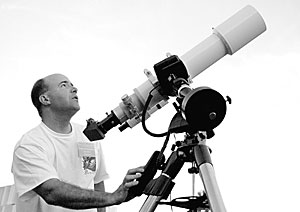 |
|
Chris Coduto/Arizona Daily Wildcat
|
Volunteer Flandrau telescope operator Edward Stramler aims his telescope at Venus on the UA Mall Saturday night. Stramler was on the Mall as part of Mars Mania, an event educating people about the UA connection to the Mars Reconnaissance Orbiter launced earlier this month.��
|
|
|
By Evan Pellegrino
Arizona Daily Wildcat
August 29, 2005
Print this
The Phoenix Mars Mission, slated to launch in 2007, will attempt to answer one of the biggest questions intriguing humankind since the beginning of intellect; is there life beyond Earth?
Astronomers, both amateur and professional from Southern Arizona, came to the "Mars Mania" event Saturday to celebrate the successful launch of the HiRISE camera-telescope.
The event displayed telescopes on the UA Mall and featured two lectures at the Manuel T. Pacheco Integrated Learning Center from principal investigators working on two NASA missions.
Peter Smith, senior research scientist at the UA Lunar and Planetary Laboratory, is the principal investigator of the mission that will get "down and dirty" with the Martian soil.
The Phoenix probe is designed to dig holes on Mars about a meter deep.
The probe will also make Martian mud with sterilized water brought from Earth. The water and instruments on the probe must be clean of organic material to avoid discovering Earth-brought life, Smith said.
The Phoenix probe will also closely look at soil samples with a microscope.
Some soil samples will be baked in the probe's eight single-use ovens, which will reach temperatures nearing 1,000 degrees Celsius, Smith said.
As the dirt is intensely cooked, a mechanism on the craft will act as a nose, sniffing the vapor created. Smith said he believes evidence of microscopic carbon-based organisms may be present in the vapor produced.
The other UA-led mission discussed at Mars Mania is a pivotal step in Mars exploration, exploration that may someday result in a human visiting the first planet beyond Earth, said Michael Drake, the director of the Lunar and Planetary Laboratory.
The mission, HiRISE, will be less "hands-on," than the Phoenix mission; its objective is to orbit and size up the red planet, Drake said.
HiRISE is part of NASA's Mars Reconnaissance Orbiter that launched earlier this month. The mission's principal investigator is Alfred McEwen, a planetary sciences professor, who also spoke Saturday. When HiRISE reaches Mars in about 6 1/2 months, a team of UA scientists will command the camera-telescope from campus.
HiRISE will photograph Mars, and the photos will likely find good landing sites for the Phoenix and for future Mars missions, McEwen said.
Mars Mania
More information on Mars and the two current UA-led missions can be found at http://www.nasa.gov.
